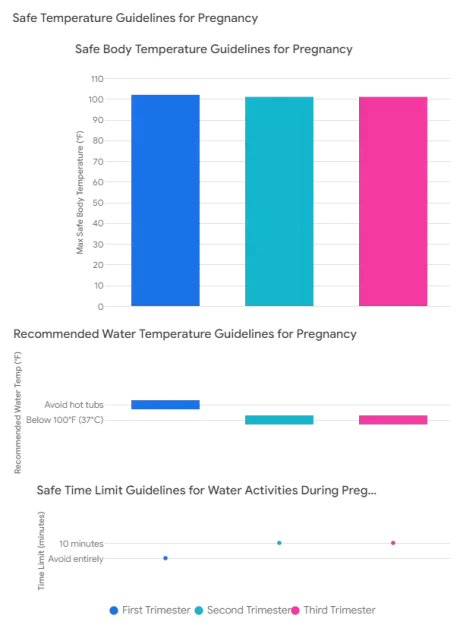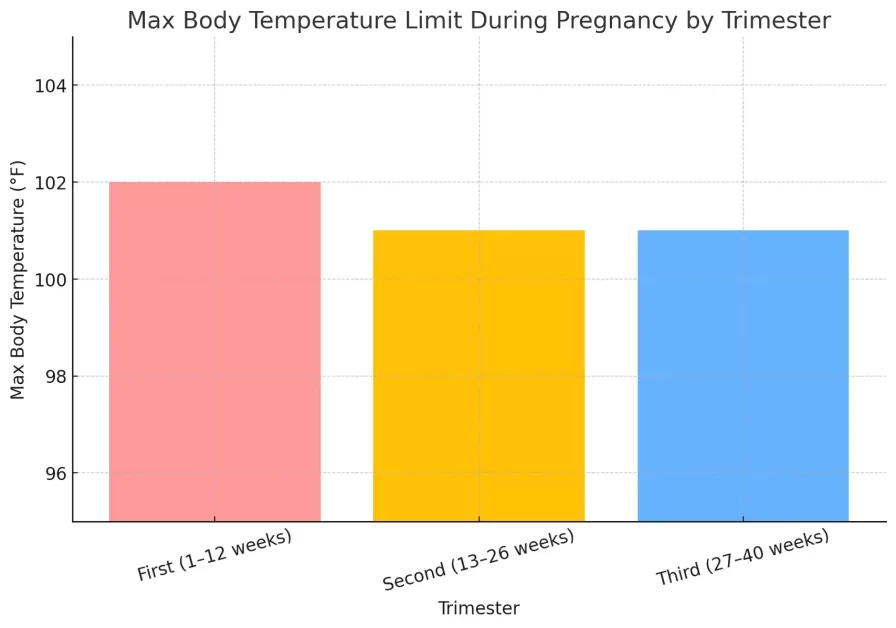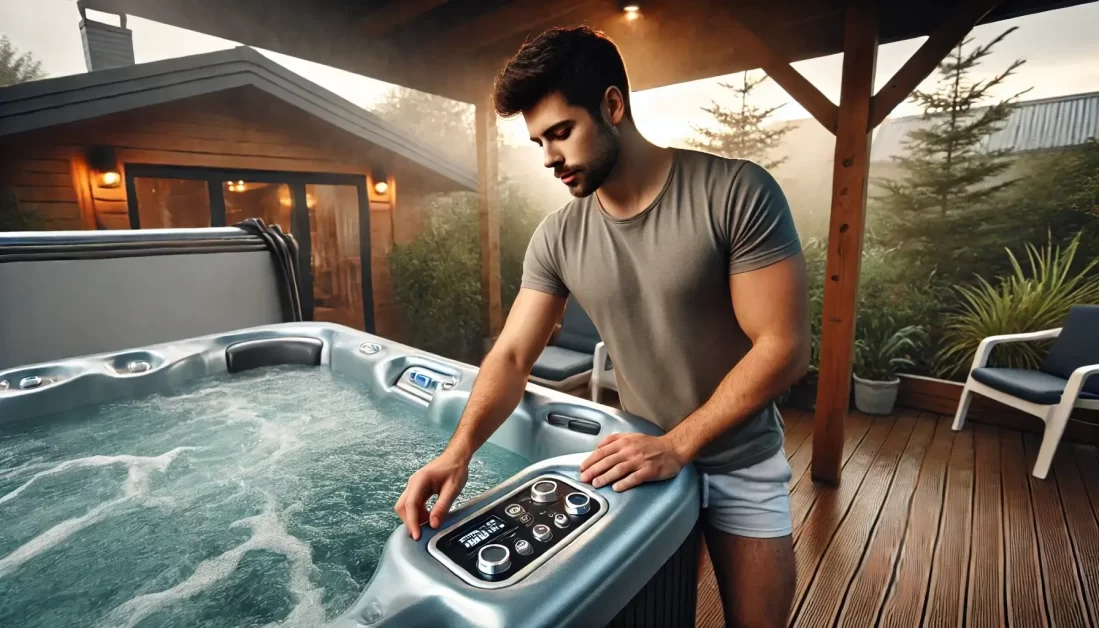Why Can not Pregnant Women Get in Hot Tubs? Risks Myths and Relaxation Tips
Pregnancy brings a lot of questions about what’s safe and what’s not. One common concern is whether it’s okay to use a hot tub.
This guide breaks down the reasons why pregnant women are often advised to avoid hot tubs, clears up some myths, and offers practical tips for relaxation during pregnancy.
| Concern | Why It Matters | Advice |
|---|---|---|
| Overheating | Risks to baby’s development | Avoid hot tubs, keep cool |
| Low blood pressure | Dizziness and fainting risk | Stay seated, hydrate well |
| Infections | Risk of illness during pregnancy | Use clean, well-maintained tubs |
| Timing (1st trimester) | Critical development phase | Avoid hot tubs entirely |
NOTE
Always consult a healthcare provider for personalized advice, especially if considering any hot tub use.
- Primary Risks Associated with Hot Tubs
- Why Can't Pregnant Women Get in Hot Tubs?
- Hot Tubs During Pregnancy: Safety and Risks
- Hot Bath vs. Hot Tub: What's the Difference?
- Risks of Using a Hot Tub During Pregnancy
- Trimester-by-Trimester Guide to Hot Tub Use
- Accidentally Used a Hot Tub While Pregnant – What Now?
- Safe Water Temperature Guidelines for Pregnant Women
- Practical Tips for Using a Hot Tub Safely During Pregnancy
- Hot Tub Myths and Misconceptions During Pregnancy
- Safer Alternatives to Hot Tubs for Pregnant Women
- FAQs
Primary Risks Associated with Hot Tubs
The main concern with hot tub use during pregnancy is the risk of hyperthermia, or overheating, which can occur when the body’s core temperature rises above safe levels.
Hot tubs are often set to temperatures around 104°F (40°C), and research indicates that spending even 10-20 minutes in such water can raise body temperature to 102°F or higher, exceeding the threshold of 101°F to 102.2°F considered safe by organizations like the Organization of Teratology Information Services (OTIS) and ACOG.
American Pregnancy Association – Hot Tubs & Pregnancy
Why Can’t Pregnant Women Get in Hot Tubs?
While soaking in a hot tub sounds like a great way to unwind, it can be risky during pregnancy. Here is the main concerns and safer choices:
Risks of Hot Tub Use During Pregnancy
- Overheating: Just 10 minutes in a 104°F (40°C) hot tub can raise your body temperature above 102°F (39°C), increasing the risk of birth defects.
- First Trimester Risk: Studies show that overheating early in pregnancy can lead to neural tube defects, such as spinal and brain issues.
- Infections: Hot tubs that aren’t properly maintained can harbor bacteria, potentially leading to infections harmful to both mother and baby.
- Chemical Exposure: Even with clean water, chemicals like chlorine and bromine can irritate your skin and may enter your bloodstream.

Check out our detailed article Can You Get Pregnant in a Hot Tub? to explore the facts and common misconceptions.
Safe Temperature Guidelines
| Trimester | Max Safe Body Temperature | Recommended Water Temp | Time Limit |
|---|---|---|---|
| First Trimester | 102°F (39°C) | Avoid hot tubs | Avoid entirely |
| Second Trimester | 101°F (38°C) | Below 100°F (37°C) | 10 minutes |
| Third Trimester | 101°F (38°C) | Below 100°F (37°C) | 10 minutes |
Tips to Stay Safe
- Skip the hot tub during the first trimester when your baby’s development is most vulnerable.
- Monitor your temperature using a thermometer to avoid overheating.
- Limit soak time to 10 minutes or less if you do decide to use a hot tub.
- Sit away from jets, as the water around them is hotter.
- Stay hydrated by drinking water before and after your soak.
Safe Alternatives to Hot Tubs
- Warm baths: Keep the water comfortable, not hot.
- Foot soaks: Enjoy a relaxing foot bath while sipping a cool drink.
- Prenatal massages: Relieve tension without worrying about overheating.
Hot Tubs During Pregnancy: Safety and Risks
Are Hot Tubs Safe During Pregnancy?
While pregnant isn’t recommended by health experts, especially during the first trimester. Water temperature can raise body temperature quickly, which may harm your developing baby. Here’s what to know:
- American College of Obstetricians and Gynecologists (ACOG) advises against letting core body temperature rise above 102.2°F (39°C).
- Studies show that overheating during early pregnancy can increase the risk of neural tube defects, such as brain or spinal cord problems.
- Even short soaks can cause issues—just 10 minutes in a 104°F (40°C) tub may push body temperature to unsafe levels.
Hot Bath vs. Hot Tub: What’s the Difference?
Both use warm water, they impact body temperature differently. Here’s a comparison:
|
Feature |
Hot Tub |
Hot Bath |
|---|---|---|
|
Water Temp |
Stays constantly hot (up to 104°F / 40°C) |
Cools gradually over time |
|
Body Immersion |
Full body stays submerged |
Upper body often out of water |
|
Heat Regulation |
Hard to release heat |
Body releases heat as water cools |
Why it Matters: In a hot tub, your body can’t cool itself effectively, increasing the risk of overheating. A warm bath is safer since it cools down, reducing the chance of dangerous temperature rises.
Risks of Using a Hot Tub During Pregnancy
- Overheating Risks
- Temperatures can cause hyperthermia, leading to reduced blood flow to the baby.
- Studies suggest that exposure to temperatures above 102°F (39°C) can result in neural tube defects if it happens before 7 weeks of pregnancy.
- Dehydration and Fainting
- Cause dehydration, leading to dizziness or fainting.
- Pregnant women already experience higher blood volume, making it harder to regulate body temperature.
- Infection Risks from Germs
- Poorly maintained hot tubs can harbor bacteria, increasing the risk of infections.
- Pregnant women are more prone to infections, so proper sanitation is essential.
Read our in-depth guide on the Benefits of Hot Tubs for Pregnant Women to learn how to enjoy them safely.
NOTE
Key Tip: If you decide to use a hot tub, keep the temperature below 100°F (37°C) and limit your soak time to 10 minutes or less. Always consult your doctor beforehand to ensure it’s safe for your specific situation.
Trimester-by-Trimester Guide to Hot Tub Use
Hot Tub and Pregnancy – First Trimester
During the first 12 weeks, the baby’s brain, heart, and spinal cord begin to develop, making it a crucial period. Exposure to heat above 102°F (39°C) can increase risks significantly.

- Neural tube defects: Studies show the risk of these defects doubles from 1 in 1,000 to 2 in 1,000 if core temperature rises too high before week 7.
- Risk of miscarriage: Research from the National Library of Medicine found elevated temperatures during early pregnancy might lead to an increased risk of pregnancy loss.
- Health guidance: Medical experts recommend avoiding hot tubs entirely during the first trimester to minimize any risk.
Hot Tub Use in the Second Trimester
With key organs now formed, the second trimester (13–26 weeks) presents fewer risks, but careful use of hot tubs is still necessary.
- Temperature control: Experts recommend keeping hot tub temperatures below 100°F (37°C) to avoid overheating.
- Time limits: Soaks should not exceed 10 minutes to prevent dizziness or dehydration.
- Circulation effects: Increased blood volume during this stage can make overheating more likely, so staying hydrated is critical.
- Medical advice: Always consult with your healthcare provider if you have any complications, such as high blood pressure.
Hot Tubs and Pregnancy Third Trimester
In the final trimester (27–40 weeks), increased body weight and circulation changes add new concerns. While some women find relief from muscle aches in warm water, safety must remain a priority.
- Circulation problems: Pregnant women experience up to a 50% increase in blood volume, making heat regulation harder and increasing the chance of fainting.
- Risk of early labor: Heat exposure may cause uterine contractions, potentially triggering preterm labor.
- Assistance recommended: Getting in and out of hot tubs can become challenging—use handrails or have someone assist you to avoid accidents.
|
Trimester |
Max Body Temp |
Recommended Water Temp |
Time Limit |
Key Risk |
|---|---|---|---|---|
|
First (1–12 weeks) |
102°F (39°C) |
Avoid hot tubs |
Avoid use |
Neural tube defects, miscarriage |
|
Second (13–26 weeks) |
101°F (38°C) |
Below 100°F (37°C) |
10 minutes |
Dizziness, dehydration |
|
Third (27–40 weeks) |
101°F (38°C) |
Below 100°F (37°C) |
10 minutes |
Preterm labor, fainting |
Key Tip: Keep your chest above the water to help regulate body temperature and prevent overheating. Always carry water to stay hydrated, and step out immediately if you feel lightheaded or uncomfortable.
Accidentally Used a Hot Tub While Pregnant – What Now?
Don’t panic. While prolonged exposure to high temperatures can be risky, taking immediate steps can reduce potential harm. Here’s what to do next to ensure you and your baby remain safe.
Steps to Take if You Used a Hot Tub Unintentionally
Monitor Your Body Temperature:
- If you feel overheated, measure your temperature.
- A temperature above 102°F (39°C) could indicate a risk of overheating.
Hydrate Immediately:
- Drink water to replace lost fluids and regulate your body temperature.
- Avoid caffeinated or sugary drinks, which can worsen dehydration.
Cool Down Your Body:
- Take a cool shower or place cold towels on your neck and forehead.
- Rest in a cool environment until you feel normal again.
Symptoms to Watch for After Exposure
It’s important to be mindful of any unusual symptoms that might arise after hot tub use:
- Dizziness or lightheadedness
- Nausea or feeling faint
- Excessive sweating or chills
- Uterine cramps or contractions
- Lack of fetal movement (if in the second or third trimester)
When to Consult Your Doctor
- Call your doctor immediately if your body temperature is above 102°F (39°C) for an extended period.
- Seek medical advice if you experience severe dizziness, contractions, or vaginal bleeding.
- Schedule a check-up if you notice reduced fetal movement, especially in the second or third trimester.
|
Symptom |
What It Could Mean |
When to Call the Doctor |
|---|---|---|
|
Dizziness or fainting |
Dehydration or blood pressure drop |
If it lasts longer than 15 minutes |
|
Uterine cramps |
Possible early contractions |
Immediately, especially if painful |
|
Reduced fetal movement |
Fetal distress |
If movements are significantly fewer than normal |
Pro Tip: If you’re unsure about the impact of hot tub use, err on the side of caution and contact your healthcare provider. It’s always better to be safe, even if symptoms seem mild. Check out our article on Hot Tub Use for Pregnant Women to find the guidelines and precautions.
Safe Water Temperature Guidelines for Pregnant Women
Maintaining a safe water temperature is essential for pregnant women to prevent overheating, dehydration, and potential risks to the baby. Best to avoid, or following these guidelines can help minimize the risks if you are going to use.

What Temperature Can a Pregnant Woman Use a Hot Tub?
To ensure safety, it’s crucial to keep the water temperature moderate:
- Recommended maximum water temperature: 100°F (37°C) or lower.
- Risk threshold: Water temperatures above 102°F (39°C) increase the risk of overheating and neural tube defects, especially in the first trimester.
- Factory settings: Most hot tubs are set to 104°F (40°C) by default. Be sure to lower it before use.
Reducing Health Risks in a Hot Tub
Taking extra precautions can help protect both you and your baby:
- Limit soak time:
- Stick to 10 minutes or less to avoid raising your core body temperature.
- Set a timer to prevent accidental overexposure.
- Avoid during early pregnancy:
- The first trimester is the most critical period for the baby’s development. Overheating at this stage can increase the chance of birth defects.
- Opt for alternatives like warm baths or foot soaks during this time.
- Keep your chest above water:
- Submerging only your lower body helps regulate your core temperature.
- Sitting on the edge or opposite water jets keeps you cooler and reduces exposure to heat.
| Guideline | Safe Practice |
|---|---|
| Max Water Temp | 100°F (37°C) or below |
| Soak Duration | 10 minutes or less |
| First Trimester | Avoid hot tubs entirely |
| Body Position | Keep chest above water |
| Monitor Temperature | Use a floating thermometer if available |
| Hydrate | Drink water before and after soaking |
Quick Tip: Always carry a thermometer to double-check the water temperature, even if you’re using a public hot tub. If you feel lightheaded or uncomfortable, exit the tub immediately and cool off with water or a cold towel.
Practical Tips for Using a Hot Tub Safely During Pregnancy
While it’s generally safer to avoid hot tubs during pregnancy, following these practical tips can help reduce risks if you choose to use one.
Monitor Your Body Temperature
- Use a thermometer to track your core temperature while in the tub.
- If your temperature rises above 101°F (38°C), get out immediately to avoid overheating.
- Keep your chest above water to help your body release heat more effectively.
Keep Hydrated While Soaking
- Drink plenty of water before, during, and after using the hot tub.
- Avoid caffeinated or sugary drinks, as they can contribute to dehydration.
- Proper hydration helps prevent dizziness and keeps your temperature stable.
Avoid Hot Tub Jets to Reduce Heat Exposure
- Sit away from jets since the water around them is hotter than the rest of the tub.
- Moving around in the tub can help prevent prolonged exposure to concentrated heat.
- Lower the water temperature to 100°F (37°C) or less to reduce risks.
Use Caution When Entering and Exiting the Tub
- Use handrails or ask someone to assist you to avoid slipping.
- Your center of gravity changes during pregnancy, making balance more difficult.
- Take your time when getting in and out to prevent accidents.
Consult Your Doctor Before Using Hot Tubs or Saunas
- Always check with your healthcare provider before using hot tubs, especially if you have a high-risk pregnancy or medical conditions.
- Your doctor can guide you based on your unique situation, including how long you can safely soak.
- If you experience contractions, dizziness, or unusual symptoms, avoid hot tubs altogether and seek medical advice.
Hot Tub Myths and Misconceptions During Pregnancy
Some confusion around using hot tubs during pregnancy. While some risks are well-documented, others are overblown. Let’s separate fact from fiction to give you peace of mind.
Is It Safe to Rest Your Feet in the Hot Tub?
- Fact: Resting your feet in a hot tub is generally safe if the water isn’t too hot.
- Reason: Immersing just your feet won’t raise your core body temperature to a dangerous level.
- Precautions: Keep the water temperature below 100°F (37°C) and limit the soak to 10 minutes to avoid swelling or discomfort.
Just stay hydrated and avoid placing your feet near water jets, as the temperature tends to be higher in those areas.
Hot Tub Pregnancy Myths Debunked
- Myth: Hot tubs are dangerous at any temperature during pregnancy.
- Reality: Hot tubs are safer when set to 100°F (37°C) or below and used for short periods (10 minutes or less).
- Myth: Soaking in a hot tub always causes birth defects.
- Reality: The risk of neural tube defects only rises when body temperature exceeds 102°F (39°C) during the first trimester. Proper use reduces this risk significantly.
- Myth: You should never use a hot tub throughout pregnancy.
- Reality: Using a hot tub in the second or third trimester may be safe with doctor approval, provided you limit time and monitor water temperature.
- Myth: Hot tubs are cleaner than public pools.
- Reality: Hot tubs can harbor bacteria if not properly maintained. Always ensure chlorine or bromine levels are within safe ranges (chlorine: 2–4 ppm, bromine: 4–6 ppm).
Safer Alternatives to Hot Tubs for Pregnant Women
These 4 alternatives are safe and provide comfort and relief, helping to soothe aches, reduce swelling, and promote well-being during your pregnancy.
1. Warm Baths with Temperature Control
- A warm bath can offer relaxation without raising your core temperature dangerously.
- Keep the water at or below 100°F (37°C) to stay safe.
- Studies suggest that baths, unlike hot tubs, allow your body to release heat more easily since part of your body is not submerged.
- Limit bath time to 20 minutes to avoid any risk of overheating, and always have a glass of water nearby to stay hydrated.
2. Prenatal Spa Treatments and Massage
- Prenatal massages help relieve back pain, muscle tension, and stress while promoting better sleep.
- Research shows that 80% of pregnant women experience back pain, and massage can reduce discomfort without needing heat therapy.
- Look for spas specializing in prenatal treatments and ensure the massage table is designed to accommodate your growing belly.
- Avoid heated elements during massages to prevent unnecessary temperature rises.
3. Foot Soaking Stations
- A foot soak with warm water (below 37°C / 98.6°F) can relieve tired feet and reduce swelling, especially in the third trimester.
- Swelling affects 75% of pregnant women, making foot soaks a gentle, effective way to relax.
- Add Epsom salts or essential oils like lavender for an extra calming effect. Limit soak time to 10-15 minutes and follow with moisturizing lotion to keep skin soft.

4. Using Heat Packs or Warm Towels for Relaxation
- A heat pack or warm towel applied to sore muscles offers localized relief without overheating your whole body.
- Studies recommend limiting the use of heating pads to 15-20 minutes to avoid burns or discomfort.
- Use a towel between your skin and the heat source to prevent irritation, and never apply heat directly to your belly.
- These methods can help ease muscle cramps, neck pain, and tension without the risks of hot tubs or saunas.
NOTE
Always wise to consult your healthcare provider before using hot tubs or heated water sources.
🔗 Explore More Hot Tub Resources
Discover everything you need to know about hot tubs, from installation tips to health benefits.













